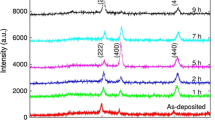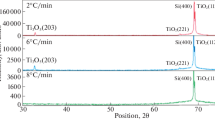Abstract
The thermal conductivity of amorphous indium zinc oxide (IZO) thin films was measured by the 3ω method. Three IZO films were prepared by dc magnetron sputtering method on Si substrate under different O2 flow ratios (O2 / [Ar+O2]) of 0%, 1%, and 5%. The thermal conductivity of IZO films decreases with an increase in O2 flow ratio, the values of the thermal conductivity were 3.4, 3.1 and 1.2 W m-1 K-1 for O2 flow ratios of 0%, 1%, and 5%, respectively. To investigate relationships among the thermal conductivity, the structure and other physical properties, we were carried out nanoindentation, Rutherford back scattering (RBS), electron spin resonance (ESR). The result of ESR measurements indicated that the amount of conduction electron in the IZO film decreases with increasing O2 flow ratio. Increase of O2 flow ratio reduces the amount of oxygen vacancies for providing free electrons. Therefore, decreasing thermal conductivity with an increase in O2 flow ratio is attributed to decreasing conduction electrons as thermal carrier. On the other hand, the chemical composition of IZO films is independent of O2 flow ratio. Furthermore, density, Young’s modulus and hardness also show little changes with increasing O2 flow ratio. Density, Young’s modulus and hardness are strongly associated with the internal structure. It is probable that influence of oxygen vacancies on the internal structure of IZO film is negligibly small.
Similar content being viewed by others
References
T. Yagi, K. Tamano, Y. Sato, N. Taketoshi, T. Baba, Y. Shigesato, J. Vac. Sci. Technol. A 23, 1180–1186 (2005).
T. Ashida, A. Miyamura, Y. Sato, T. Yagi, N. Taketoshi, T. Baba, Y. Shigesato, J. Vac. Sci. Technol. A 25, 1178–1183 (2007).
T. Ashida, A. Miyamura, N. Oka, Y. Sato, T. Yagi, N. Taketoshi, T. Baba, Y. Shigesato, J. Appl. Phys. 105, 073709 (2009).
D. G. Cahill, Rev. Sci. Instrum. 61, 802–808 (1990).
S.-M. Lee, D. G. Cahill, J. Appl. Phys. 81, pp.2590–2595 (1997).
D. G. Cahill, A. Bullen, S.-M. Lee, High temperatures-high pressures 32, 135–142 (2000).
T. Yamane, N. Nagai, S. Katayama, M. Todoki, J. Appl. Phys. 91, 9772–9776 (2002).
N. Ito, Y. Sato, P. K. Song, A. Kaijo, K. Inoue, and Y. Shigesato, Thin Solid Films 496, 99–103 (2006)
Author information
Authors and Affiliations
Rights and permissions
About this article
Cite this article
Endoh, R., Hirano, T., Takeda, M. et al. Thermal Conductivity of Amorphous Indium Zinc Oxide Thin Films. MRS Online Proceedings Library 1315, 1105 (2011). https://doi.org/10.1557/opl.2011.777
Published:
DOI: https://doi.org/10.1557/opl.2011.777




